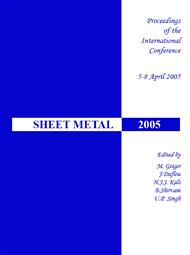[1]
D.R.J. Owen and E. Hinton: Finite Elements in Plasticity. (Pineridge Press Limited, Swansea, U.K. 1980).
Google Scholar
[2]
C.K. Choi and Y.M. Park: Conforming and nonconforming transition plate bending elements for an adaptive h-refinement, Thin-Walled Structures Vol. 28 (1997), p.1.
DOI: 10.1016/s0263-8231(97)00007-4
Google Scholar
[3]
T.A. Ozkul and U. Ture: The transition from thin plates to moderately thick plates by using finite element analysis and the shear locking problem. Thin-Walled Structures Vol. 42 (2004), p.1405.
DOI: 10.1016/j.tws.2004.05.003
Google Scholar
[4]
M.M. Hrabok and T.M. Hrudey: A review and catalogue of plate bending finite elements. Computers and Structures, Vol. 19 (1984), p.479.
DOI: 10.1016/0045-7949(84)90055-5
Google Scholar
[5]
C. Jeyachandrabose and J. Kirkhope: An alternative explicit formulation for the DKT plate bending element. International Journal for Numerical Methods in Engineering Vol. 21 (1985), p.1289.
DOI: 10.1002/nme.1620210709
Google Scholar
[6]
J.L. Meek, H.S. Tan: A Discrete Kirchhoff plate bending element with loof nodes. Computers and Structures Vol. 21 (1985), p.1197.
DOI: 10.1016/0045-7949(85)90175-0
Google Scholar
[7]
C. Jeyachandrabose, J. Kirkhope and L. Meckisho: An improved discrete Kirchhoff quadrilateral thin plate bending element. International Journal for Numerical Methods in Engineering Vol. 24 (1987), p.635.
DOI: 10.1002/nme.1620240312
Google Scholar
[8]
J.L. Batoz, C.L. Zheng and F. Hammadi: Formulation and evaluation of new triangular, quadrilateral, pentagonal and hexagonal discrete Kirchhoff plate/shell elements. International Journal for Numerical Methods in Engineering Vol. 52 (2001), p.615.
DOI: 10.1002/nme.295
Google Scholar
[9]
I.H. Güzelbey, B. Kanber: A Practical Rule for the Derivation of Transition Finite Element, International Journal for Numerical Methods in Engineering, Vol. 47 (2000), p.1029.
Google Scholar
[10]
B. Kanber: Finite element analysis of contact problems using transition elements, (MSc Thesis, University of Gaziantep, Turkey 1997).
Google Scholar


